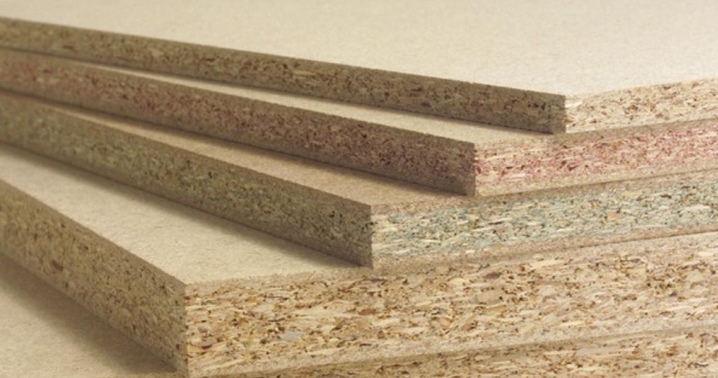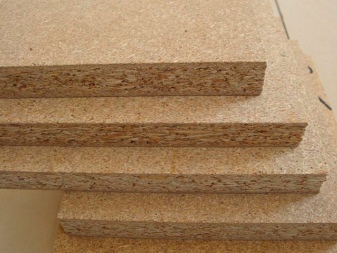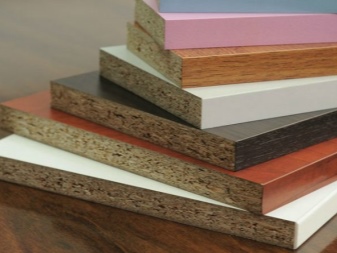All about chipboard

Among all construction and finishing materials used for repair and finishing works and furniture manufacture, chipboard takes a special place. What is wood-based polymer, what varieties of this material exist and in what areas it is used - we will talk about these and other issues in our article.


What it is?
Chipboard stands for "chipboard". This is a sheet building material, it is produced by pressing crushed wood shavings impregnated with glue. The idea of obtaining such a composite was first seen 100 years ago. Initially, the board was covered with plywood on both sides. In the future, the technology was constantly improved, and in 1941 the first factory for the production of chipboard began work in Germany. After the end of World War II, the technology of making slabs from woodworking industry wastes became widespread.

The interest in such material is explained by a number of technical properties:
- stability of dimensions and shapes;
- the simplicity of making large-format sheets; using waste from the woodworking industry instead of expensive wood.
Thanks to the serial production of chipboard, the volume of waste during timber processing has decreased from 60 to 10%. At the same time, the furniture industry and the construction industry have acquired a practical and affordable material.



Main characteristics
Let's consider the main characteristics of chipboard.
- Strength and density. There are two groups of slabs - P1 and P2. Products P2 have a high bending strength - 11 MPa, for P1 this indicator is lower - 10 MPa, therefore the P2 group has a high resistance to delamination. The density of panels of both groups varies in the range of 560-830 kg / m3.
- Moisture resistance. Water resistance is not regulated in any way by existing standards. However, this material can only be used in dry conditions. Some manufacturers have launched the production of waterproof products; they are made with the introduction of a water repellent.
- Biostability. Chipboards are highly bioinert - the boards do not damage pests, mold and fungi do not multiply on them. The slab can completely deteriorate and collapse from water, but even then rot will not appear in its fibers.
- Fire safety. The fire hazard class for chipboard corresponds to the 4th flammability group - the same as wood. Although this material does not ignite as quickly as natural wood, the fire spreads more slowly.
- Environmental friendliness. When buying chipboard, you need to pay attention to the emission, it is determined by the level of phenol-formaldehyde vapor release. Only materials with emission class E1 may be used in residential premises. For hospitals, as well as kindergartens, schools and children's rooms, only stoves with an emission class of E 0.5 can be used - they contain a minimum amount of phenol formaldehyde.
- Thermal conductivity. The thermal insulation parameters of chipboard are low, and this must be taken into account when using materials as cladding. On average, the thermal conductivity of the panel is 0.15 W / (m • K). Thus, with a sheet thickness of 16 mm, the thermal resistance of the materials is 0.1 (m2 • K) / W. For comparison: for a red brick wall with a thickness of 39 cm, this parameter is 2.22 (m2 • K) / W, and for a layer of mineral wool of 100 mm - 0.78 (m2 • K) / W.That is why it is advisable to combine the paneling with an air gap.
- Water vapor permeability. Permeability to water vapor corresponds to 0.13 mg / (m • h • Pa), therefore this material cannot be a vapor barrier. But when using chipboard for external cladding, high vapor permeability, on the contrary, will help drain condensate from the wall.



Comparison with MDF
Ordinary users often confuse MDF and chipboard. Indeed, these materials have a lot in common - they are made from woodworking industry waste, that is, from pressed wood shavings and sawdust. The difference lies in the fact that for the manufacture of MDF, smaller fractions of raw materials are used. In addition, the adhesion of particles occurs with the help of lignin or paraffin - this makes the boards absolutely safe and environmentally friendly. Due to the presence of paraffin, MDF is highly moisture resistant.
That is why this material is often used for the manufacture of elements of furniture structures and interior doors, as well as for the construction of partitions. Chipboards are not used in this area.

Production
Almost any woodworking waste is used for the manufacture of particle boards:
- substandard round timber;
- knots;
- slabs;
- leftovers from edging boards;
- trimming;
- chips;
- shavings;
- sawdust.



The production process includes several stages.
Preparation of raw materials
At the preparatory stage of work, lumpy waste is crushed into chips, and then, together with large shavings, is brought to the required size with a thickness of 0.2-0.5 mm, a length of 5-40 mm and a width of up to 8-10 mm.
Peel off the round timber, cut it into small pieces, soak it, then split it into fibers and grind it to optimal condition.

Forming and pressing
The prepared material is mixed with polymer resins, they act as the main binder. These manipulations are performed in a special device. Particles of wood in it are in a suspended state, resin is sprayed on them by a diffusion method. This technology makes it possible to maximally cover the entire working surface of the wood shavings with an adhesive composition and at the same time prevent excessive consumption of the adhesive composition.
Resinated shavings go into a special dispenser, here they are laid out in a continuous sheet on a conveyor in 3 layers and fed into a vibrating press. As a result of primary pressing, briquettes are formed. They are heated to 75 degrees and sent to a hydraulic press. There, the plates are affected by a temperature of 150-180 degrees and a pressure of 20-35 kgf / cm2.
As a result of the complex action, the material is compacted, the binder component is polymerized and hardened.

Bringing to readiness
The finished sheets are stacked in high piles and left under their own weight for 2-3 days. During this time, the degree of heating is leveled in the slabs and all internal stresses are neutralized. At the stage of final processing, the surface is sanded, veneered and cut into plates of the required size. After that, the finished product is marked and sent to the consumer.

Harm to health
Since the moment when the chipboard manufacturing technology was invented, disputes about the safety of this material have not subsided. Some people argue that particle board is completely safe when used correctly. Their opponents are trying to prove the harm of the product.
To debunk all the myths and doubts, let's take a closer look at the reasons that can make the chipboard toxic.
Phenol-formaldehyde resins that are part of the glue are a potential hazard. Over time, formaldehyde evaporates from the adhesive and accumulates in the airspace of the room. So, if you lock a person in a hermetically sealed room of a small volume and put a sheet of chipboard near him, then over time the gas will begin to fill the room.Sooner or later, its concentration will reach the maximum permissible values, after which the gas will begin to bind with protein cells in tissues and organs and lead to pathological changes in the body.
Formaldehyde poses the greatest danger to the skin, eyes, respiratory organs, the central nervous, and also the reproductive system.


However, one should not lose sight of the fact that air exchange is constantly taking place in any living room. Part of the air masses escapes into the atmosphere, and clean air from the street comes in their place.
That is why chipboard can only be used in rooms with good ventilation; with regular ventilation, the content of toxic fumes can be minimized.
Another argument made by opponents of wood-based materials. lies in the fact that in the event of burning chipboard, it releases toxic substances. This is indeed the case. But do not forget that any organic matter during combustion emits at least carbon dioxide and carbon monoxide, and if carbon dioxide is dangerous only in high concentrations, then carbon monoxide can kill even in small volumes. In this regard, stoves are no more dangerous than any synthetic clothing, household appliances and home electronics. - all of them in a fire emit poisonous gases that can seriously harm a person.


Species overview
There are several types of chipboard.
- Pressed chipboard - has increased strength and density. It is used as a structural material for furniture and construction work.
- Laminated chipboard - a pressed panel covered with a paper-resin coating. Lamination increases the hardness of the surface many times over and increases its resistance to wear. If desired, a pattern can be printed on paper that enhances the laminate's similarity to natural materials.
- Moisture resistant chipboard - used in rooms with high humidity. Its characteristics are ensured by the addition of special hydrophobic additives to the glue.
- Extruded plate - does not have the same precision as pressed. The fibers are placed in it perpendicular to the plane of the plate. Such products can be tubular and strip. They are mainly used for noise insulation.



Pressed boards are subdivided according to several more criteria.
- By density - into groups P1 and P2. The first is general purpose products. The second combines the materials used to make furniture.
- By structure - slabs can be ordinary and fine-structured. For lamination, it is better to give preference to the latter, since their surface perceives the finish better.
- By the quality of surface treatment - can be sanded and not sanded. They are divided into first and second grade slabs. For each of them, the GOST contains a list of unacceptable defects. The highest quality product belongs to the first grade.
- The surface of the chipboard can be refined - veneered, glossy, varnished. On sale are decorative laminated and non-laminated products, plastic coated models.

Dimensions (edit)
There is no generally accepted standard of parameters approved all over the world. Therefore, most manufacturers adhere only to restrictions in terms of the minimum dimensions - 120 cm wide and 108 cm long. However, this has nothing to do with regulatory restrictions.
The dimensions are determined solely by the peculiarities of the manufacturing and transportation technology.
So, it will be much easier to transport panels up to 3.5 m long and less than 190 cm wide, since these parameters correspond to the dimensions of the body of an average truck. All others will be much more difficult to transport. Nevertheless, chipboards up to 580 cm long and up to 250 cm wide can be found on sale, they are produced in limited quantities. The thickness of the slabs varies from 8 to 40 mm.

As practice shows, the most common sheets of the following sizes:
- 2440x1220 mm;
- 2440x1830 mm;
- 2750x1830 mm;
- 2800x2070 mm.

Marking
Each plate should include the following information:
- dimensions in mm;
- grade;
- manufacturer and country of origin;
- surface category, strength and moisture resistance class;
- emission class;
- the degree of processing of the ends;
- compliance with approved standards;
- number of sheets in a package;
- date of manufacture.
The marking is applied inside the rectangle.
Important: for plates manufactured at domestic enterprises or legally supplied from foreign countries, all information, except for the brand name, should be indicated only in Russian.


Popular manufacturers
When choosing chipboard, it is better to give preference to trusted manufacturers. Today, the top manufacturers of chipboard in Russia include:
- "Monzensky DOK";
- Cherepovets FMK;
- "Sheksninsky KDP";
- Pfleiderer plant;
- "Zheshart FZ";
- Syktyvkar Federal Law;
- Intrast;
- "Karelia DSP";
- MK "Shatura";
- "MEZ DSP and D";
- Skhodnya-Plitprom;
- "EZ chipboard".
When buying cheap products from little-known companies, there is always a high risk of becoming the owner of low-quality products that use a lot of phenol-formaldehyde resins.



Where is it applied?
Chipboard is used in various areas of construction, decoration and production.
Internal cladding of the house
Particleboard of emission class E0.5 and E1 can be used for interior cladding of premises. This material has a high hardness. Sanded boards can be painted with any paints and varnishes, if desired, you can stick wallpaper on them, put tiles or apply plaster. Before finishing the premises, chipboard surfaces should be primed with acrylic compound and glued with a serpyanka mesh.
Due to the low vapor permeability, the inner lining should be ventilated. Otherwise, condensation will settle on the walls, and this will lead to the formation of rot and mold.

Load-bearing partitions
Aesthetic partitions are obtained from chipboard, they are attached to a metal or wooden frame. The resistance of such a partition to static loads and rigidity directly depend on the characteristics of the frame itself and the reliability of its fixation.
But the thickness of the chipboard affects the impact resistance.


Fencing
During the construction of facilities, it is often necessary to fence the site in order to protect pedestrians or cars passing by from damage. These barriers indicate a closed area, because the structures are made portable - they consist of a metal frame and chipboard sheathing with a thickness of 6 to 12 cm. Any warning labels can be made on the surface. In order for the paint to serve as long as possible and not to peel off under the influence of external unfavorable factors, the surface is treated with a primer, it is advisable to use acrylic. Moreover, you need to process the plate on both sides and additionally grease the ends.
Such a treatment reliably covers the chip material and protects the board from moisture absorption during rain and snow.


Formwork
For such an application, only water-resistant chipboards impregnated with hydrophobic components can be used. The strength and rigidity of the formwork directly depend on the correct installation of the spacers, as well as the thickness of the slab. The higher the height of the area to be poured with concrete, the greater the pressure in the lower part of the formwork. Accordingly, the material should be as thick as possible.
For a concrete layer up to 2 m high, it is best to use 15 mm chipboard.

Furniture
Chipboard is characterized by high strength, therefore it is used in the manufacture of various types of furniture. Prepared furniture modules are pasted over with a paper-laminated film with a wood texture or covered with a laminate. The appearance of such furniture is almost indistinguishable from similar blocks made of solid wood. To create cabinet furniture, chipboard with a thickness of 15-25 mm is usually used, plates with a thickness of 30-38 mm are used for milling.
Not only body modules are made of chipboard, but also tabletops, in this case, chipboard with a thickness of 38 mm or more is taken. A piece of the desired shape is cut out of the sheet, the ends are cut with a mill, polished, pasted over with veneer or paper, followed by lamination and varnishing.


Window sills
Chipboard 30 and 40 mm thick can be used to create window sills. The part is first cut to size, after which the ends are milled, giving them the desired shape. Then pasted over with paper and laminated.
Such window sills look like products made of solid wood.

Other
All kinds of containers are made from chipboard. The material was widely used to create Euro pallets, which are designed to move packed goods.
Such a container is considered disposable, it is expensive to make it out of wood. Due to the fact that chipboard is much cheaper than metal and wood, significant savings can be achieved.
Many summer residents make garden furniture from such pallets - they make unusual garden loungers, sofas and swings.


Due to the low cost of chipboard and the ability to give the slabs the texture of valuable wood species, the material is very popular. Chipboards are considered to be a practical substitute for expensive natural solid wood elements.
For more information on chipboard, see the next video.













The comment was sent successfully.